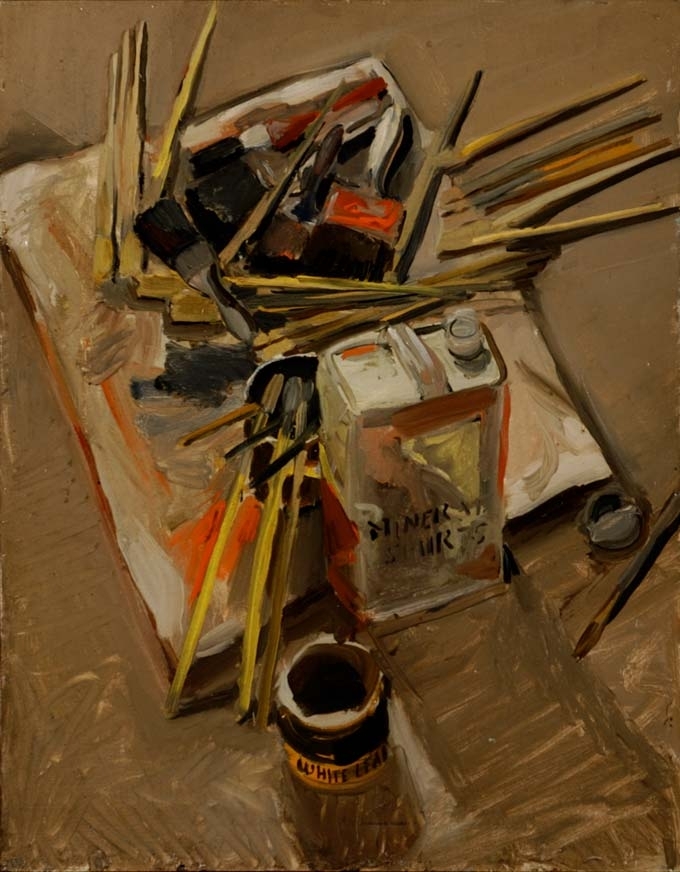Museum Exhibit Offers Insight into the Creative Process of American Master Fairfield Porter

“Fairfield Porter: Raw—The Creative Process of an American Master”
May 19—August 14, 2011
For immediate release: 5/19/11
For further information contact: Richard Saunders, Director, at rsaunder@middlebury.edu
Middlebury, VT—Fairfield Porter: Raw—The Creative Process of an American Master, an exhibition of approximately forty works drawn from the extensive Porter holdings at the Parrish Art Museum, Southampton, NY, opened on May 19 at the Middlebury College Museum of Art and will remain on view through Aug. 14. Originally organized for the Parrish Art Museum by Klaus Ottmann, Fairfield Porter: Raw includes not only completed paintings and works on paper but also unfinished paintings and accompanying sketches, drawings, and ephemera. Many of the works are exhibited “raw”—unframed and unmatted—to convey an unprecedented insight into Porter’s creative process. The exhibition is accompanied by a fully illustrated catalogue, which is available for purchase at the museum’s reception desk.
In 1949 Fairfield Porter established his home and studio on South Main Street in Southampton, where he lived until his death in 1975. Four years later some 250 works were given to the Parrish by his widow Anne. The bequest included, in addition to major paintings and important works on paper, a large number of works in various states of completion, including a sketchbook, unstretched paintings on canvas that had been stored by the artist rolled-up, and many paintings on various kinds of boards.
Drawing on this vast archive, Fairfield Porter: Raw makes clear that, while Porter was a figurative painter, it was the materiality of paint and the process of painting, rather than content or even a “finished” product, which mattered most to him. “I was beginning to be interested in what you can do with paint, what is the quality of paint, what is its nature,” he told Paul Cummings in an interview. “What matters is the painting.” William Agree wrote, “Porter refused to make any concessions to either sentiment or traditional canons of finish or painterly quality…He believed that a painting exists in time and changes in time.” Porter himself told Paul Cummings, “I think that Ingres’s remark that ‘I leave it to time to finish my paintings’ is true in a very wide and profound way.”
As Klaus Ottmann observes in his catalogue essay An Unfinished Quality: Fairfield Porter’s Creative Process, a casual, spontaneous, artless, even unfinished look informed much of the artist’s work. Porter’s biographer Justin Spring described the artist’s house and studio as “always in a state of lively disorder.” Painter and critic Rackstraw Downes recalls that “as a painter, he was studiously casual,” while painter Jane Freilicher, like Downes a close friend of Porter’s, once said, “An ‘unfinished’ quality…was part of his paintings. The same sort of casualness you find in the household you find in his paintings.” Many of the works in the exhibition have that unfinished quality, some intentionally, some because they were unfinished at the time of his death. The figures in two of Porter’s unfinished paintings from the 1950s, John, Richard, and Laurence and an untitled portrait of a man seated near a lamp, lack facial features. However, in a late portrait of his daughter Katie from 1971-73, which is signed and dated, her facial features, hands, and feet lack definition. Similarly, his Self-Portrait in the Studio (ca. 1950) deliberately leaves out facial details. Two unfinished landscapes from the 1960s reveal Porter’s practice of beginning with pale washes of thin paint as he explored color in relation to composition.
In a 1955 ARTNews article “Porter Paints a Picture,” the poet Frank O’Hara referred to “a look of spontaneity and effortless felicity” in Porter’s paintings and attributed their freshness in part to the artist’s use of medium. Porter studied technique and material with French art restorer Jacques Maroger at the Parsons School of Design and became an advocate of Maroger’s medium, a mixture of white lead, linseed oil, and mastic, which allowed the brush to move fluidly across the canvas. Porter developed a variant of the original medium and prepared it in his studio according to a complicated formula. He also kept meticulous records of his paint mixtures, making clear that the apparent casualness of his paintings did not reflect an indifference to technique.
Porter’s sketchbook pages have been digitized and are shown in the exhibition on a small digital frame. To distinguish finished paintings from unfinished works in the exhibition, the unfinished stretched canvases are hung without frames, while the paintings on boards are displayed leaning against the wall on picture rail moldings. This presentation allows visitors to experience not only the composition and color of each work, but also its “materiality”—canvas, Masonite, corrugated cardboard, and even asbestos or aluminum sheets—affording unique insights into the mind and the artistic practice of this modern master.
The presentation of Fairfield Porter: Raw—The Creative Process of an American Master and its catalogue are made possible, in part, with generous support from the Henry Luce Foundation, the Robert Lehman Foundation, the Herman Goldman Foundation, and James Goodman.
The Middlebury College Museum of Art, located in the Mahaney Center for the Arts on Rte. 30 on the southern edge of campus, is free and open to the public Tues. through Fri. from 10 a.m. to 5 p.m., and Sat. and Sun. from noon to 5 p.m. It is closed Mondays. The museum is physically accessible. Parking is available in the Center for the Arts parking lot. For further information, please call (802) 443–5007 or TTY (802) 443–3155, or visit the museum’s website at museum.middlebury.edu.
